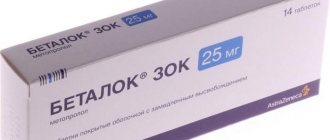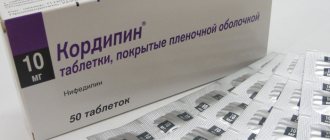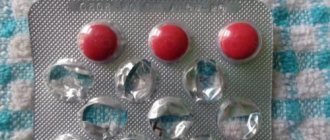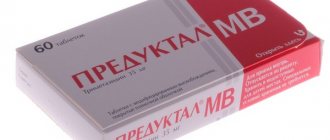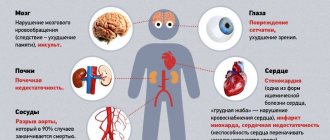Pharmacological properties of the drug Betaloc zok
Metoprolol is a competitive cardioselective β1-adrenergic receptor blocker. It has a slightly pronounced membrane-stabilizing effect and does not have partial agonist activity. Metoprolol eliminates or reduces the stimulating effect of catecholamines on the heart during physical and psychoemotional stress, reduces heart rate, moderately reduces myocardial contractility and cardiac output, and also reduces high blood pressure. Reduces myocardial oxygen demand and increases diastole. At high concentrations of endogenous adrenaline, metoprolol affects blood pressure to a much lesser extent than non-selective beta-adrenergic receptor blockers. Unlike traditional tablet dosage forms, when using Betaloc ZOK tablets with a delayed release of the active substance, a constant concentration of the drug in the blood plasma is observed and a stable clinical effect is ensured (blockade of β1-adrenergic receptors) for more than 24 hours. Due to the absence of concentration peaks in the blood plasma Betaloc ZOK is characterized by better clinical tolerability than conventional tablet forms of β1-adrenergic receptor blockers - the potential risk of side effects that are observed at peak plasma concentrations of the drug, such as bradycardia and weakness in the lower extremities when walking, is significantly reduced. If necessary, Betaloc ZOK can be prescribed in combination with β2-adrenergic receptor agonists to patients with COPD. In therapeutic doses, metoprolol in combination with β2-adrenergic receptor agonists has a lesser effect on bronchial tone compared to non-selective β-adrenergic receptor blockers. Betaloc ZOK has a lesser effect on insulin release and carbohydrate metabolism than non-selective beta-adrenergic receptor blockers. The effect of Betaloc ZOK on the response of the cardiovascular system in conditions of hypoglycemia is much less pronounced than that of non-selective beta-adrenergic receptor blockers. Clinical studies have shown that Betaloc ZOK may cause a slight increase in TG levels and a decrease in plasma free fatty acid levels. In some cases, a slight decrease in the HDL fraction was noted, but it was less significant compared to taking non-selective β1-adrenergic receptor blockers. However, one long-term clinical study showed a significant reduction in total cholesterol levels after treatment with metoprolol for several years. In the MERIT-HF study (Effect of Metoprolol Therapy on Survival in NYHA Class II–IV Heart Failure with Reduced Ejection Fraction (≤40%)), which included 3991 patients, metoprolol therapy resulted in a reduction in mortality and hospitalization. With long-term treatment, patients showed an improvement in their condition and a decrease in the functional class of heart failure according to NYHA. Metoprolol therapy led to an increase in left ventricular ejection fraction and a decrease in left ventricular end-systolic and diastolic volumes. Betaloc ZOK is completely absorbed after oral administration. Absorption of the drug does not depend on food intake. Due to active metabolism during first pass through the liver, the systemic bioavailability of metoprolol after oral administration is approximately 50%. When the sustained-release formulation of metoprolol is used, its bioavailability is reduced by approximately 20–30% compared to conventional tablets, but this is not clinically significant because the sustained-release formulation has the same AUC as the conventional tablet. Metoprolol is characterized by a low degree of binding to plasma proteins (approximately 5–10%). Metoprolol is metabolized in the liver, producing three metabolites that do not have β-adrenergic blocking activity. More than 95% of the drug dose taken orally is excreted in the urine, 5% is excreted unchanged. In some cases, the amount of the drug that is excreted unchanged in the urine can reach 30%. The mean half-life is 3.5 hours (1–9 hours). The total plasma clearance is approximately 1 l/min. In elderly patients, significant changes in the pharmacokinetics of metoprolol are not observed. Systemic bioavailability and excretion of metoprolol do not change in patients with renal failure, but the excretion of metabolites in such patients is reduced. Significant accumulation of metabolites was observed in patients with a glomerular filtration rate of less than 5 ml/min. Such accumulation of metabolites does not have a β-adrenergic blocking effect. In patients with reduced liver function, the pharmacokinetics of metoprolol (due to low protein binding) changes slightly, however, in patients with severe liver cirrhosis or portacaval shunts, the bioavailability of metoprolol may be increased and overall clearance may be decreased. In patients with a portacaval shunt, the total clearance of metoprolol is approximately 0.3 l/min, and the AUC value is approximately 6 times higher than that in healthy individuals.
Pharmacodynamics and pharmacokinetics
Metoprolol significantly reduces or completely eliminates the effect of catecholamines during mental , physical and emotional stress . In addition, it moderately reduces heart rate and myocardial contractility . Has a hypotensive effect.
Betaloc may slightly increase TG levels and reduce the concentration of free fatty acids in the blood serum. In some cases, the level lipoproteins .
Betaloc solution for myocardial infarction helps reduce the severity of pain, as well as reduce the risk of ventricular fibrillation and atrial fibrillation . In the early period of a heart attack, it helps to limit the affected area and the spread of necrosis .
Betalok solution spreads quickly, within a few minutes. At a dose of up to 20 mg, the pharmacokinetics are linear. The half-life is on average 3-4 hours. Absorbed by 95%, the remaining substances are excreted unchanged.
Indications for use of the drug Betaloc zok
- arterial hypertension (AH) (to reduce blood pressure and the risk of developing coronary and other cardiovascular complications, as well as cardiovascular and coronary death, including sudden death);
- angina pectoris;
- compensated chronic heart failure with impaired left ventricular systolic function (as an addition to the basic treatment of heart failure);
- in order to reduce mortality and the incidence of recurrent infarction after the acute phase of myocardial infarction;
- heart rhythm disturbances, including supraventricular tachycardia, as well as to reduce the frequency of ventricular contractions during atrial fibrillation and ventricular extrasystoles;
- functional disorders of cardiac activity;
- migraine prevention.
Use of the drug Betaloc zok
Betaloc ZOK is intended for daily use once a day, preferably in the morning. Tablets (or tablets split in half) should not be chewed or crushed. Food intake does not affect the bioavailability of the drug. During dose selection, heart rate should be monitored to prevent bradycardia. Hypertension (arterial hypertension) The recommended dose of Betaloc ZOK for patients with mild or moderate hypertension (arterial hypertension) is 50 mg 1 time per day. If the therapeutic effect is not achieved, the dose should be increased to 100–200 mg once a day or combined with other antihypertensive drugs. Angina pectoris The recommended dose is 100–200 mg Betaloc ZOK 1 time per day. If necessary, Betaloc ZOK can be combined with other drugs for the treatment of angina. Stable chronic heart failure with impaired left ventricular systolic function (as an addition to basic therapy) Patients must be in the stage of compensated chronic heart failure for at least 6 weeks; basic therapy should not change during the last 2 weeks. Treatment of heart failure with β-adrenergic blockers may lead to transient clinical deterioration. Further continuation of therapy or dose reduction is possible; in some cases, discontinuation of the drug may be necessary. Initiation of therapy with Betaloc ZOK in patients with severe heart failure (NYHA IV) should be carried out by an experienced physician experienced in treating patients with heart failure. Stable chronic heart failure, functional class II The recommended initial dose of Betaloc ZOK for the first 2 weeks is 25 mg (1 tablet of 25 mg or tablets of 50 mg) 1 time per day. After 2 weeks, the dose can be increased to 50 mg once a day and then can be doubled every 2 weeks. The optimal dose for long-term treatment is 200 mg Betaloc ZOK 1 time per day. Stable chronic heart failure, functional class III-IV The dose is selected individually. The recommended initial dose for the first 2 weeks is 12.5 mg Betaloc ZOK (1/2 tablet of 25 mg) 1 time per day. During the period of increasing the dose, the patient should be under the supervision of a physician, as in some cases the symptoms of heart failure may intensify. After 2 weeks of taking Betaloc ZOK at a dose of 12.5 mg, the dose can be increased to 25 mg (1 tablet of 25 mg or tablets of 50 mg) once a day. After 2 weeks, the dose can be increased to 50 mg once a day. For patients who tolerate higher doses well, the dose can be doubled every 2 weeks until a maximum dose of 200 mg Betaloc ZOK is reached once a day. In case of hypotension and/or bradycardia, it is necessary to reduce the dose of Betaloc ZOK or concomitant medications. Hypotension at the beginning of therapy does not necessarily indicate that such a dose of Betaloc ZOK will not be tolerated in the future. However, the dose should not be increased until the patient's condition has stabilized. Monitoring of kidney function is necessary. Cardiac arrhythmias The recommended dose is 100–200 mg Betaloc ZOK 1 time per day. Maintenance therapy after myocardial infarction It has been shown that as a result of long-term treatment with Betalok ZOK at a dose of 200 mg per day, the risk of death (including sudden death) is reduced, and the risk of recurrent myocardial infarction is reduced (including in patients with diabetes mellitus). Functional cardiac disorders accompanied by palpitations The recommended dose is 100 mg Betaloc ZOK 1 time per day. If necessary, the dose can be increased to 200 mg. Prevention of migraine The recommended dose is 100–200 mg Betaloc ZOK 1 time per day. Patients with impaired renal function No dose adjustment is required in patients with impaired renal function. Patients with impaired liver function Betaloc ZOK is usually prescribed to patients with liver cirrhosis at the same dose as patients with normal liver function. Only in case of severe liver failure is it possible to reduce the dose. Elderly patients No dose adjustment is required. Children Experience with the use of Betaloc ZOK in children is limited.
Reviews of Betaloka ZOK
Reviews of Betalok ZOK indicate that quite often after its use undesirable symptoms occur. Thus, patients often report cases of rhinitis . Some also complain of irregular pulse and instability of blood pressure . Because of this, specialists prescribe additional medications that are designed to eliminate these side effects. However, it should be noted that most people still tolerate this medication easily.
In addition, reviews of Betalok ZOK draw attention to the fact that the selection of dosages should be approached with particular care. The patient’s condition must be constantly monitored and the danger of deterioration must be eliminated in a timely manner.
Contraindications for Betaloc zok
AV blockade II–III degree; heart failure in the decompensation phase (pulmonary edema, hypoperfusion syndrome or arterial hypotension), simultaneous (long-term or periodic) therapy with inotropic agents aimed at stimulating β-adrenergic receptors; clinically significant sinus bradycardia, sick sinus syndrome, cardiogenic shock, severe peripheral arterial circulation disorders. Metoprolol should not be prescribed to patients with suspected acute myocardial infarction with a heart rate less than 45 per minute, a P-Q on the ECG of more than 0.24 s, or a systolic blood pressure level of less than 100 mmHg. Art. Hypersensitivity to any component of the drug or to other beta-adrenergic receptor blockers.
Side effects of the drug Betaloc zok
Well tolerated, side effects are usually mild and reversible. Side effects according to the frequency of occurrence are distributed as follows: very often - at least 10%, often - 1-9%, infrequently - 0.1%, rarely - 0.01-0.09%, very rarely - less than 0.01% . From the cardiovascular system Often: bradycardia, postural disturbances (extremely with dizziness), coldness of the extremities; uncommon: temporary worsening of symptoms of heart failure, 1st degree AV block, edema, pain in the heart area; rarely: sinoatrial conduction disturbance, arrhythmia; very rare: gangrene in patients with severe peripheral circulatory disorders. From the side of the central nervous system Very often: increased fatigue; often: dizziness, headache; uncommon: paresthesia, muscle cramps. From the gastrointestinal tract Often: nausea, abdominal pain, diarrhea, constipation; uncommon: vomiting; rarely: dry mouth. From the blood system : Very rare: thrombocytopenia. From the hepatobiliary system Rarely: changes in functional liver parameters; very rare: hepatitis. From the musculoskeletal system Very rare: arthralgia. Metabolic disorders : Uncommon: weight gain. Mental status: Uncommon: depression, decreased concentration, drowsiness or insomnia, nightmares; rarely: increased excitability, anxiety; very rarely: amnesia and other memory impairments, confusion, hallucinations. From the respiratory system Often: shortness of breath with physical effort; not often: bronchospasm; rarely: rhinitis. From the senses : Rarely: visual disturbances, dryness and/or irritation of the eyes, conjunctivitis; very rarely: taste disturbances, tinnitus. Skin disorders Uncommon: rash (urticaria, areas of skin dystrophy), increased sweating; rarely: hair loss; very rarely: photosensitivity, exacerbation of psoriasis. Other Impotence, sexual dysfunction.
Special instructions for the use of the drug Betaloc zok
Patients taking beta-blockers should not receive intravenous verapamil-type calcium antagonists. As a rule, when treating patients with asthma, β2-adrenergic receptor agonists (in tablets or aerosol) are prescribed as concomitant therapy. In cases where these patients begin to take Betaloc ZOK, an increase in the dose of β2-adrenergic receptor agonists may be necessary. The risk that Betaloc ZOK will affect β2-adrenergic receptors is lower than in the case of the use of conventional non-selective β1-adrenergic receptor blockers in tablets. Betaloc ZOK has a lesser effect on insulin release and carbohydrate metabolism than non-selective beta-adrenergic receptor blockers. In patients with chronic heart failure, compensation for the disease should be achieved before starting the use of Betaloc ZOK, and during its use they should be under medical supervision. In extremely rare cases, the condition of patients with moderate AV conduction disorders may worsen (possible development of complete AV block). If bradycardia develops during treatment, the dose of Betaloc ZOK should be reduced or the use of the drug should be gradually discontinued. Betaloc ZOK may increase the severity of peripheral arterial circulatory disorders by reducing blood pressure. Patients with pheochromocytoma should be prescribed an α-adrenergic receptor blocker simultaneously with Betaloc ZOK. When performing surgery, it is necessary to warn the anesthesiologist that the patient is taking Betaloc ZOK. However, it is not recommended to discontinue treatment with beta-adrenergic blockers in patients scheduled for surgery. Data on the effectiveness and safety of the drug in patients with severe stable heart failure (NYHA functional class IV) are limited. These patients must be treated by physicians with specialized skills and experience. Abrupt discontinuation of β-adrenergic blockers should be avoided, as this may worsen heart failure and also increase the risk of myocardial infarction and sudden cardiac death. If treatment must be stopped, this should be done as gradually as possible, over a period of at least 2 weeks under medical supervision. The dose is reduced by half at each stage. The last dose (12.5 mg) should be taken for at least 4 days until the drug is completely discontinued. If symptoms return, it is recommended to slow down the dose reduction. Anaphylactic shock in patients taking metoprolol is more severe. Pregnancy and lactation Betaloc ZOK can be prescribed during pregnancy only if the expected therapeutic effect for the mother outweighs the potential risk to the fetus. β-adrenergic receptor blockers can cause the development of bradycardia in the fetus and newborn, which should be taken into account when prescribing the drug in the third trimester of pregnancy, as well as during childbirth. It is unlikely that metoprolol prescribed to the mother in therapeutic doses will have a negative effect on the infant. Effect on the ability to drive vehicles and work with potentially dangerous mechanisms Since dizziness and weakness may develop when using the drug, caution should be exercised when driving vehicles and working with potentially dangerous mechanisms.
Betaloka ZOK price, where to buy
The average price of Betaloc ZOK 50 mg is 270 rubles, the price of 25 mg is 160 rubles, and the average cost of 100 mg of the drug is 370 rubles.
- Online pharmacies in RussiaRussia
- Online pharmacies in UkraineUkraine
ZdravCity
- Betaloc ZOK tablets p.p.o.
with deceleration release 50 mg 30 pcs. Astra Zeneca AB/LLC Astra Zeneca Industries 306 rub. order - Betaloc ZOK tablets p.p.o. with deceleration release 100 mg 30 pcs. AstraZeneca AB / Astra Zeneca Industries LLC
RUB 375 order
- Betaloc ZOK tablets p.p.o. with deceleration release 25 mg 14 pcs. AstraZeneca AB / ZiO-Zdorovye / Astra Zeneca Industries LLC
132 RUR order
Pharmacy Dialogue
- Betalok Zok (tablet p/o 100 mg No. 30)Astra Zeneсa/AstraZeneca Industries
403 rub. order
- Betaloc Zok tablets 25 mg No. 14Astra Zenesa/AstraZeneca Industries
RUB 141 order
- Betalok Zok (tablet p/o 25 mg No. 14)Astra Zeneca/ZIO Health
129 RUR order
- Betaloc Zok tablets 50 mg No. 30Astra Zenesa/AstraZeneca Industries
RUB 276 order
- Betalok Zok (tablet p/o 50 mg No. 30)Astra Zeneca/ZIO Health
RUB 278 order
show more
Pharmacy24
- Betaloc Zok 100 mg N30 Astra Zeneca AB, Sweden
199 UAH order - Betaloc Zok 50 mg N30 tablets Astra Zeneca AB, Sweden
142 UAH order
- Betaloc Zok 25 mg No. 14 tablets Astra Zeneca AB, Sweden
80 UAH order
Interactions of the drug Betaloc zok
Patients should be under medical supervision if other beta-adrenergic receptor blockers (for example, in the form of eye drops), ganglion blockers, or MAO inhibitors are simultaneously prescribed with Betaloc ZOK. Concomitant use with propafenone should be avoided. Propafenone inhibits the metabolism of metoprolol via cytochrome P450 2D6. The result of using this combination is unpredictable, since propafenone also has a β-adrenergic blocking effect. If clonidine is suddenly discontinued during treatment with beta-adrenergic blockers, blood pressure may increase. If it is necessary to discontinue concomitant therapy with clonidine, the β-adrenergic blocker should be discontinued several days before discontinuing clonidine. In patients taking calcium antagonists such as verapamil or diltiazem and/or antiarrhythmic drugs simultaneously with Betaloc ZOK, a negative ino- and chronotropic effect may develop. In patients taking β-adrenergic blockers, intravenous administration of verapamil is contraindicated (risk of cardiac arrest). β-adrenergic receptor blockers can enhance the negative ino- and chronotropic effects of antiarrhythmic drugs (quinidine analogues, amiodarone). In patients receiving treatment with beta-adrenergic blockers, the use of inhalational anesthetics increases the severity of the cardiodepressive effect. Inducers or inhibitors of microsomal liver enzymes may affect the concentration of metoprolol in blood plasma. Metoprolol plasma concentrations are reduced by concomitant use of rifampicin or may be increased by concomitant use of cimetidine, phenytoin, alcohol, hydralazine and serotonin reuptake inhibitors (paroxetine, fluoxetine and sertraline). With simultaneous use of indomethacin or other COX inhibitors, the antihypertensive effect of beta-adrenergic blockers may be reduced. Cardioselective beta-adrenergic blockers have a significantly lesser effect on blood pressure when patients are given epinephrine than non-selective beta-adrenergic blockers. When taking beta-adrenergic blockers concomitantly, dose adjustment of oral antidiabetic agents may be necessary.
Betalok's analogs
Level 4 ATC code matches:
Biol
Metocard
Metozok
Nebilet
Nebilong
Betaxolol
Bisogamma
Aritel
Cordinorm
Vasocardin
Corvitol
Bidop
Bisoprolol
Nebivolol
Biprol
Bisoprol
Concor Cor
Lokren
Concor
Niperten
Pharmacies sell analogues of Betalok such as:
- Azoprol Retard;
- Vasocardin;
- Egilok Retard.
- Corvitol;
- Metocore;
- Betaloc ZOK;
- Metoprolol;
- Metoprolol Zentiva;
- Metoprolol Tartrate.
Betalok ZOK belongs to the same manufacturer and, as a rule, Betalok itself is compared with it.
What is the difference between Betalok ZOK and Betalok?
The question is often asked on forums: what is the difference Betalok ZOK and Betalok. Experts explain that in the first case, the medicine does not act immediately. The active substances are released gradually, and therefore the drug is better tolerated. Its side effects are less pronounced. Both medications, however, Betaloc and Betaloc ZOK , are sold in pharmacies strictly according to a prescription.
Overdose of the drug Betaloc zok
Symptoms: severe arterial hypotension, sinus bradycardia, AV block, heart failure, cardiogenic shock, cardiac arrest, bronchospasm, disturbances of consciousness up to coma, nausea, vomiting, cyanosis of the extremities. Concomitant use of alcohol, antihypertensive drugs, quinidine or barbiturates may worsen the patient's condition. The first symptoms develop 20 minutes to 2 hours after an overdose. Treatment: gastric lavage, taking activated carbon. In cases of severe arterial hypotension, bradycardia, or the threat of developing heart failure, administration of a β1-adrenergic receptor agonist (for example, prenalterol) intravenously at intervals of 2–5 minutes or as an infusion is indicated until a therapeutic effect is achieved. In the absence of a selective β1-adrenergic receptor agonist, it can be replaced by intravenous dopamine or atropine sulfate to block the vagus nerve. If a therapeutic effect cannot be achieved, other sympathomimetics (dobutamine or norepinephrine) can be used. Administration of glucagon at a dose of 1–10 mg is indicated. It may be necessary to use a pacemaker. To relieve bronchospasm, a β2-adrenergic receptor agonist is administered intravenously. It should be borne in mind that the doses of antidotes that are necessary to eliminate the symptoms of an overdose of a β-adrenergic receptor blocker are much higher than therapeutic doses, since β-adrenergic receptors are bound by their blockers.

